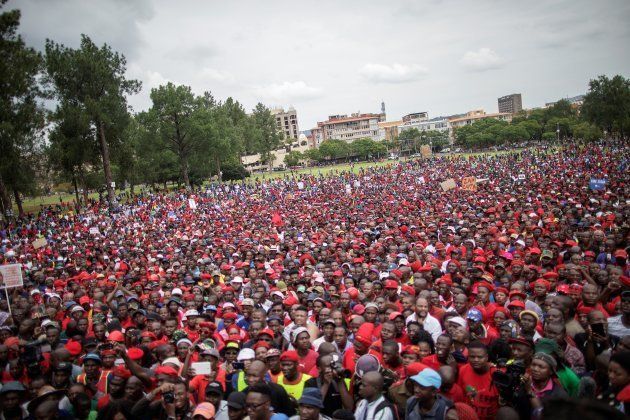
ANALYSIS
The opposition parties promised that Wednesday's "National Day of Action" would be a mass action. They promised that it would encompass the leadership and supporters of seven political parties, straddling virtually every position on the political spectrum. They promised it would be peaceful, but forceful. They promised to make themselves heard.
On 12 April, they delivered on all of those promises in Pretoria.
For the first time ever in democratic South Africa, a huge range of political alignments came together in one mass action. Members of the African Christian Democratic Party, African Independent Congress, African People's Convention, Congress of the People, Agang, the Democratic Alliance, Economic Freedom Fighters, Inkatha Freedom Party and the United Democratic Movement met together at Church Square in Pretoria. Then they marched on the Union Buildings, and in one voice, demanded that President Jacob Zuma step down immediately.
Previous attempts at demonstrations at the Union Buildings, including the student protests, were marred by incidents of violence and looting. There was none of that on Wednesday. The march was peaceful. And it was huge. Estimates vary, but the police expected 10,000 people to show up. More people than that showed up. The hue was unmistakably black – but the march was multi-racial too.
While all animals were equal, it was evident that the red animals are more equal than the others. From the very outset, various overhead and crowd shots showed that the colours of the EFF dominated. They arrived first at Church Square and quickly spread out, showing up in every single shot that was shared on social media and television. The DA crowds arrived some 30 minutes later, but their effect was quickly diluted as the different factions were ordered to mix together. At the Union Buildings, the most prominent colour was red.

The EFF dominance was clear on the stage too. The secretary-general Godrich Gardee led proceedings. The national spokesperson Mbuyiseni Ndlozi charmed the crowd with his sweet baritone. The national chairperson Dali Mpofu made an attempt at singing, and mercifully settled on a call-and-response chant. These were the opening acts of course. When the EFF president Julius Malema, the rock star of South African political rallies, took to the stage, the crowd were screaming his name before he'd taken the microphone in his hand.
It was Malema who delivered the hardest punches. Zuma made a fumbling attempt at discrediting last week's marches against him by smearing them as racist. His chief critic flung the accusation back in his face. "If you call us racists, we are proud racists because we do not want this man," he said. "If not wanting Zuma is racism, then we are racists."
Malema is a genius of political theatre. At an event when emotions were naturally elevated, he took the time to calmly explain, in Sepedi, exactly how South Africa's sub-investment grade credit rating would do to the pockets of ordinary citizens. He explained how money meant for social grants would be diverted to debt management programmes, and how basic food items would become more expensive. The ANC has repeatedly failed to do this. Rather, its leadership has dismissed the idea that junk status would have any real effect on the poor.
Once it was over, the march subsided quickly. But the moment should not be seen to have passed. It was meaningful. It was significant.
After the local government elections last year, the deals that were struck for coalition governments in Johannesburg, Pretoria and Port Elizabeth happened in secret. The parties were wary of each other. Threats were passed back and forth. The EFF in particular worked hard to distance itself from the untidy marriage it was party to. This time, Malema walked hand-in-hand with the DA representatives, and those of other political parties. (The DA should be singled out for praise: it was important that all of the party leaders were black, but they were the only party represented by a woman, Phumzile van Damme.) It was out in the open. They walked through the streets of the city they had taken from the ANC the year before.
The symbolism of it all was unmissable.
